|
Week 8: September 19 - 25, 2013 |
Welcome
to the McGill Bird Observatory weekly report.
Click here for a complete listing of our archives.
Comments or
questions are welcome at "mbo AT migrationresearch.org".
|
PICTURE
OF THE WEEK: |
|
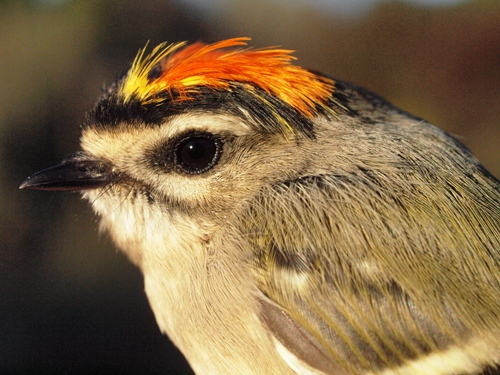
It's late September at MBO, and right on schedule the kinglets have started to arrive,
including this adorable male Golden-crowned Kinglet.
(Photo by Simon Duval)
-
|
|
|
THIS WEEK |
THIS FALL |
2013 TOTAL |
SITE TOTAL |
|
# birds (and species) banded |
205 (37) |
2020 (68) |
3315 (86) |
44827 (113) |
|
# birds (and species) repeat |
63 (18) |
508 (37) |
838 (51) |
8819 (70) |
|
# birds (and species) return |
4 (2) |
38 (16) |
193 (35) |
1402 (38) |
|
# species observed |
74 |
136 |
164 |
209 |
|
# net hours |
541.5 |
4176.5 |
7533.3 |
76823.0 |
|
# birds banded / 100 net hours |
37.9 |
48.4 |
44.0 |
58.3 |
|
|
Note: table does not include nocturnal banding (owls) |
|
Banders-in-charge: Simon Duval, Gay Gruner
Assistants: Christine Barrie, Nicolas Bernier, Sue Bishop, Marc Boisvert, Cindy Bouchard, Luke Currin, Rui de Jesus, Jean Demers, Geneviève Dubois, Michael Fleming, Nicki Fleming, Barbara Frei, Jo-Annie Gagnon, Marcel Gahbauer, Nathalie Gendron, Alison Hackney, Lisa Keelty, Lance Laviolette, Christie Lovatt, Barbara MacDuff, Don MacDuff, Betsy McFarlane, Marie Perkins, Benoit Piquette, Catherine Russell, Ahmad Shah, Clémence Soulard, Patricia Stotland, Rodger Titman
Notes: For the third straight year, week 8 was a bit of a lull in terms of migration, at least with respect to the number of birds banded. The count of 205 birds banded this week was actually the lowest ever for this period, although remarkably similar to last year's 210 and the 209 banded in week 8 of 2007. The number of species banded (37) was also similar to those two years (36 in 2012 and 39 in 2007), and below average. Until now, the season total has been higher than in any previous fall - but given that in 2010 we banded 1279 birds in week 8, this year's total now pales in comparison to that (though it's still more than in any of the other seven years of MBO's Fall Migration Monitoring Program). The slowdown in migration was not reflected in observations, as the 88 species observed matched the week 8 record set way back in 2005 (and is very close to the 87 species observed in both 2011 and 2012). For the second week in a row, we set a new all-time record for species diversity in fall, with 65 observed on September 25.
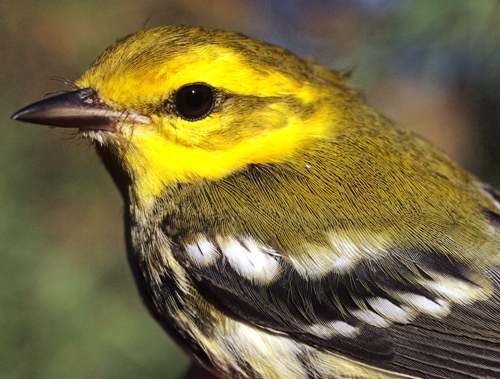
Past mid-September, warbler diversity starts to decline, but the "black-throated" species (green above, blue below) are among the ones still regularly observed at MBO.
(Photos by Simon Duval)
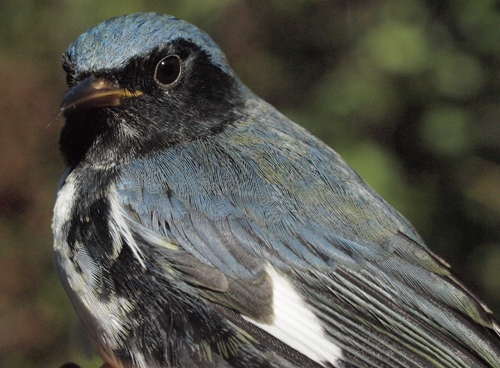
|
The most noteworthy sighting this week was a Greater White-fronted Goose flying over MBO twice on the morning of September 21, with a small flock of Canada Geese. It became the first "new" species observed at MBO since Tufted Titmouse in June 2012, and increased the site list to 208 species. Another five species were observed for the first time this fall - Osprey, Peregrine Falcon, American Pipit, White-crowned Sparrow, and Slate-colored Junco. Long overdue, we finally banded our first Blackburnian Warbler of fall (in past years, almost all of them have been banded in August), as well as our first Palm Warbler, White-crowned Sparrow, and Slate-colored Junco.
This week’s top 10 [last week's rank in brackets]
# individuals banded |
mean # individuals observed daily |
1. White-throated Sparrow (23) [3] |
1. Canada Goose (283) [4] |
2. Magnolia Warbler (19) [1] |
2. American Crow (72) [2] |
2. Song Sparrow (19) [10] |
3. Red-winged Blackbird (71) [5] |
4. Tennessee Warbler (18) [2] |
4. White-throated Sparrow (27) [4] |
5. Golden-crowned Kinglet (14) [10] |
5. Blue Jay (25) [8] |
6. Ruby-crowned Kinglet (12) [-] |
6. Black-capped Chickadee (22) [10] |
6. Red-eyed Vireo (12) [6] |
7. American Goldfinch (19) [6] |
8. American Redstart (11) [7] |
8. Song Sparrow (18) [-] |
9. Nashville Warbler (9) [9] |
9. American Robin (13) [-] |
10. Gray Catbird (6) [-]
10. Black-throated Blue Warbler (6) [10]
|
10. European Starling (13) [3]
|
|
Except in 2011, the top species banded in week 8 has been very numerous, ranging from 60 individuals to a remarkable 881 (Yellow-rumped Warblers in 2010). In 2011 the top spot went to Magnolia Warbler with only 28; this year the bar was lowered even farther with only 23 White-throated Sparrows (this species was also number one in 2005, 2007, 2009, and 2012). After three weeks on top, Magnolia Warbler dropped to second place, tied with Song Sparrows, on the increase again as presumed boreal migrants begin to arrive. Tennessee Warblers are slipping slightly at last, but still continuing to add to their record season. In the middle of the pack this week were the two kinglets, with their numbers sure to increase more as we enter October. Red-eyed Vireo numbers continue to remain strong week after week, and we banded more American Redstarts than ever before in week 8, bringing their season total to a near-record 145 with good potential for a few more late stragglers over the next week or two. Staying in ninth and tenth place this week, respectively, were Nashville Warbler and Black-throated Blue Warbler, with Gray Catbird also increasing enough for a tenth place tie.
Canada Goose numbers shot up dramatically this week, as they often do in week 8. Crows remained in second place, just barely ahead of Red-winged Blackbirds, whose numbers are growing as we approach October. For the seventh time in nine years, White-throated Sparrows were abundant enough to be among the top five species observed in week 8. Except for 2010 and 2012 when there were unusually big flights of Blue Jays during week 8 (mean daily totals of 77 and 75, respectively), the daily count has been in the mid-20s other years, and this year was the same. Black-capped Chickadees and American Goldfinches remain present in good numbers, while the increase in number of Song Sparrows banded was also reflected in observations. American Robin numbers are starting to build as we move toward late fall, and although European Starling dropped to tenth place this week, we suspect it will increase again as part of the October mixed blackbird flocks.
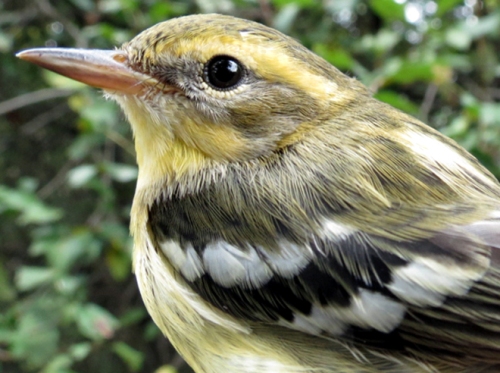
Although three Blackburnian Warblers were observed earlier in fall, this one was the first one to be banded at MBO this season.
(Photo by Gay Gruner)
|
Sneak preview of what's to come ... kinglets on the increase, plust the start of the owl banding season - watch for the week 9 report soon!
|
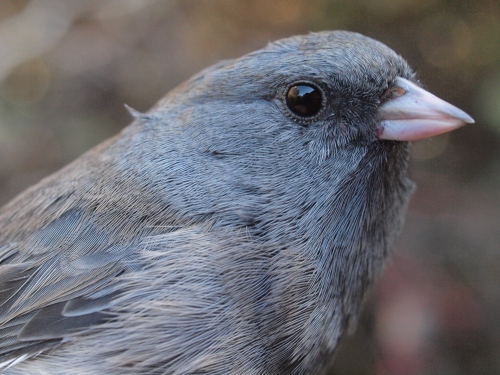
A sure sign that we have turned the corner into late fall, with the first Slate-colored Junco of the season observed and banded.
(Photo by Simon Duval)
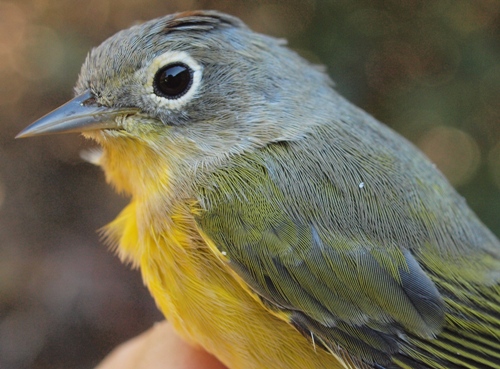
Despite a decent number of Nashville Warblers this week, the season total of 41 banded to date is still fewer than in any previous fall. However, given that we usually continue to band them into November, the previous low of 50 in 2007 will likely be surpassed.
(Photo by Simon Duval)
|






